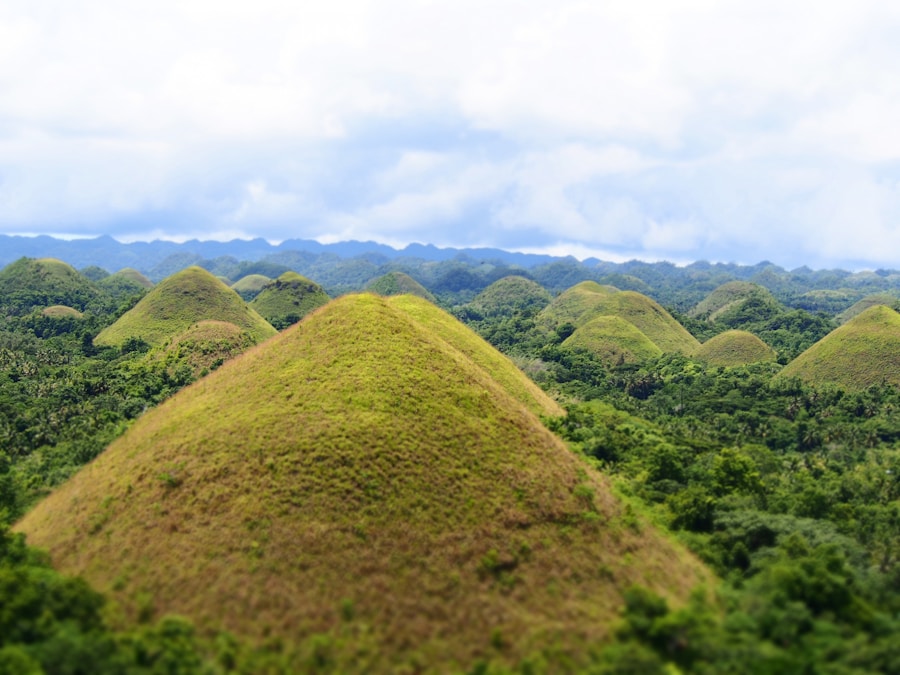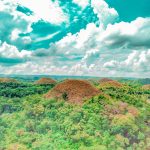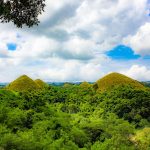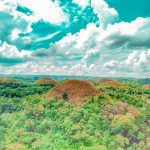Download links
How to install The Mysterious Chocolate Hills: A Natural Wonder APK?
1. Tap the downloaded The Mysterious Chocolate Hills: A Natural Wonder APK file.
2. Touch install.
3. Follow the steps on the screen.
Description
The Chocolate Hills, a geological wonder located in the heart of Bohol, Philippines, are one of the most iconic natural landmarks in the country. This unique landscape consists of over 1,200 symmetrical hills that rise dramatically from the surrounding flat terrain, creating a breathtaking panorama that attracts tourists and nature enthusiasts alike. The hills are named for their distinctive brown color during the dry season, resembling mounds of chocolate, while they are lush green during the rainy season.
This striking visual transformation has contributed to their allure, making them a must-visit destination for travelers seeking both beauty and adventure. The Chocolate Hills are not only a feast for the eyes but also a source of intrigue for geologists and scientists. Their unusual formation has sparked numerous theories and studies, leading to a deeper understanding of the natural processes that shape our planet.
The hills are often described as a natural phenomenon, and their unique characteristics have earned them a place on the UNESCO World Heritage Tentative List. As visitors explore this enchanting landscape, they are not only treated to stunning views but also an opportunity to appreciate the intricate interplay between nature and geology that has resulted in this remarkable site.
Key Takeaways
- The Chocolate Hills are a famous geological formation in the Philippines, consisting of over 1,200 cone-shaped hills.
- The formation and geology of the Chocolate Hills are still a subject of debate, with theories ranging from coral reefs to volcanic activity.
- The flora and fauna of the Chocolate Hills are diverse, with a variety of plant and animal species inhabiting the area.
- The Chocolate Hills hold cultural significance for the Filipino people, with legends and folklore surrounding their origin.
- Conservation efforts for the Chocolate Hills are ongoing, with initiatives to protect the area’s natural beauty and biodiversity.
Formation and Geology of the Chocolate Hills
The Role of Erosion and Limestone
The region is primarily composed of limestone, which is susceptible to weathering and erosion by rainwater. Over millions of years, the continuous action of water has carved out the landscape, resulting in the creation of these conical hills. The process is believed to have begun during the Pleistocene epoch when sea levels fluctuated, exposing limestone deposits that were subsequently shaped by natural forces.
Tectonic Activity and Uplift
In addition to erosion, tectonic activity has played a significant role in shaping the Chocolate Hills. The region is situated on a tectonic plate boundary, where movements in the Earth’s crust have contributed to the uplift of limestone formations. This geological activity has resulted in the distinctive conical shapes of the hills, which can reach heights of up to 120 meters.
A Visually Stunning Landscape
The unique topography is further enhanced by the surrounding flatlands, creating a striking contrast that captivates visitors. The combination of these geological processes has resulted in a landscape that is not only visually stunning but also rich in geological history.
Flora and Fauna of the Chocolate Hills

The Chocolate Hills are not just a geological marvel; they also support a diverse array of flora and fauna that thrive in this unique environment. The hills are primarily covered with grass, which turns brown during the dry season, giving rise to their name. However, this seemingly barren landscape is home to various plant species that have adapted to the local climate.
Grasses such as cogon grass and other hardy plants dominate the area, providing essential cover for wildlife and contributing to the overall ecosystem. In terms of fauna, the Chocolate Hills are home to several species of birds, reptiles, and mammals. Among the most notable inhabitants are the Philippine tarsier, one of the smallest primates in the world, known for its large eyes and nocturnal habits.
These tiny creatures can often be spotted in the nearby forests, where they find shelter among the trees. Additionally, various bird species, including the Philippine eagle and different types of doves, can be observed soaring above the hills or nesting in the surrounding vegetation. The presence of these animals highlights the ecological significance of the Chocolate Hills and underscores the importance of preserving their natural habitat.
Cultural significance of the Chocolate Hills
| Aspect | Details |
|---|---|
| Number of Hills | There are around 1,268 individual hills in the Chocolate Hills area. |
| Geological Significance | The hills are considered a geological formation and are included in the Philippine Tourism Authority’s list of tourist destinations. |
| Cultural Importance | The Chocolate Hills are a prominent symbol of the province of Bohol and are included in the provincial flag and seal. |
| Local Legends | Local folklore attributes the formation of the hills to a battle between two giants throwing rocks at each other, with the hills being the remnants of their fight. |
| Tourism | The Chocolate Hills are a major tourist attraction in the Philippines, drawing visitors from around the world to witness their unique and picturesque landscape. |
The cultural significance of the Chocolate Hills extends beyond their natural beauty; they are deeply embedded in local folklore and traditions. The hills are often associated with various legends and myths that have been passed down through generations. One popular tale tells of a giant named Arogo who fell in love with a mortal woman named Aloya.
When she died, Arogo was heartbroken and wept for her loss, his tears forming the hills we see today.
Moreover, the Chocolate Hills have become a symbol of Bohol itself, representing both its natural beauty and cultural identity.
They are featured prominently in local art, literature, and tourism campaigns, serving as an emblematic representation of the province’s unique character. Festivals celebrating local culture often incorporate elements inspired by the hills, further solidifying their place in Bohol’s cultural narrative. As such, visiting the Chocolate Hills offers travelers not only a chance to witness a natural wonder but also an opportunity to engage with the local culture and history that surrounds this iconic landmark.
Conservation efforts for the Chocolate Hills
Recognizing the ecological and cultural importance of the Chocolate Hills, various conservation efforts have been initiated to protect this unique landscape from environmental degradation and human encroachment. The local government, along with environmental organizations, has implemented measures aimed at preserving both the natural environment and cultural heritage associated with the hills. These initiatives include reforestation projects to restore native vegetation and prevent soil erosion, as well as educational programs aimed at raising awareness about the importance of conservation among local communities.
Additionally, sustainable tourism practices have been promoted to ensure that visitors can enjoy the beauty of the Chocolate Hills without causing harm to their delicate ecosystem. This includes establishing designated viewing areas to minimize foot traffic on sensitive areas and encouraging responsible behavior among tourists. By fostering a sense of stewardship among visitors and locals alike, these conservation efforts aim to safeguard the Chocolate Hills for future generations while allowing people to appreciate their beauty and significance.
Visiting the Chocolate Hills: Tips and Recommendations

Timing is Everything
When planning a visit to the Chocolate Hills, timing is crucial. While each season offers its own charm, visiting during the dry season from November to May provides clearer views of the hills’ chocolate-brown hues. Early morning or late afternoon visits are ideal for capturing stunning photographs when the sunlight casts dramatic shadows across the landscape.
Maximizing Your Experience
When you arrive at the site, consider taking advantage of designated viewing platforms that offer panoramic views of the hills. These platforms provide excellent vantage points for photography and allow visitors to fully appreciate the scale and beauty of this natural wonder. Additionally, engaging with local guides can enrich your experience; they often share fascinating insights about the geology, flora, fauna, and cultural significance of the area that you might not discover on your own.
Exploring Beyond the Viewpoints
For those looking to explore beyond just viewing platforms, hiking trails around the hills offer opportunities for adventure while immersing yourself in nature. Be sure to wear comfortable shoes and bring plenty of water, especially if you plan on hiking during warmer months. Lastly, consider supporting local businesses by purchasing souvenirs or enjoying traditional Boholano cuisine at nearby eateries; this not only enhances your visit but also contributes positively to the local economy.
Creating Lasting Memories
In summary, visiting the Chocolate Hills is an experience that combines natural beauty with cultural richness. By understanding their formation, appreciating their ecological significance, engaging with local culture, supporting conservation efforts, and following practical tips for your visit, you can create lasting memories while contributing to the preservation of this extraordinary landscape.
If you’re looking for a different kind of adventure after exploring the Chocolate Hills in the Philippines, check out this article about a Guitar Band Rock Battle on taya365.my. It’s a fun and exciting event that showcases talented musicians battling it out on stage. Who knows, you might discover a new favorite band to listen to while reminiscing about your trip to the Chocolate Hills.
FAQs
What are the Chocolate Hills?
The Chocolate Hills are a geological formation located in the Bohol province of the Philippines. They are made up of around 1,200 to 1,776 conical limestone hills, which are covered in green grass that turns brown during the dry season, giving them a chocolate-like appearance.
How were the Chocolate Hills formed?
The exact formation process of the Chocolate Hills is still a subject of debate among geologists. One theory suggests that they are the weathered formations of a marine limestone on top of an impermeable layer of clay. Another theory proposes that they are the result of the uplift of coral deposits and the action of rainwater and erosion.
What is the significance of the Chocolate Hills?
The Chocolate Hills are a popular tourist attraction in the Philippines and are considered a natural wonder. They have been declared the country’s third National Geological Monument and proposed for inclusion in the UNESCO World Heritage List.
Can visitors explore the Chocolate Hills?
Yes, visitors can explore the Chocolate Hills by climbing the viewing deck in the town of Carmen or by taking a guided tour. There are also hiking trails and ziplines available for those who want to experience the hills up close.
Are there any legends or myths associated with the Chocolate Hills?
According to local folklore, the Chocolate Hills were formed from the tears of a giant named Arogo, who wept over the death of his beloved. Another legend tells the story of two giants who hurled rocks and sand at each other in a fit of rage, and when they reconciled, they left behind the Chocolate Hills.





